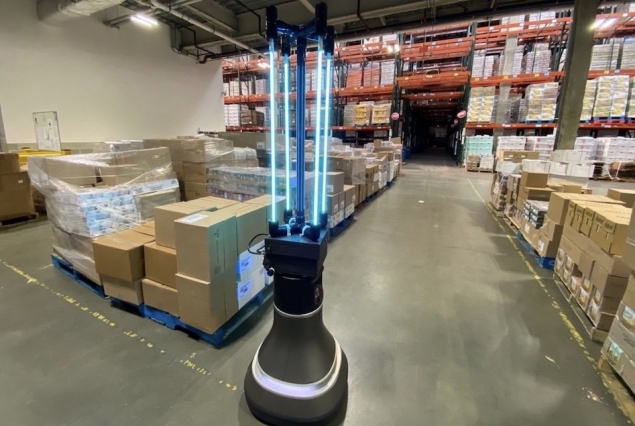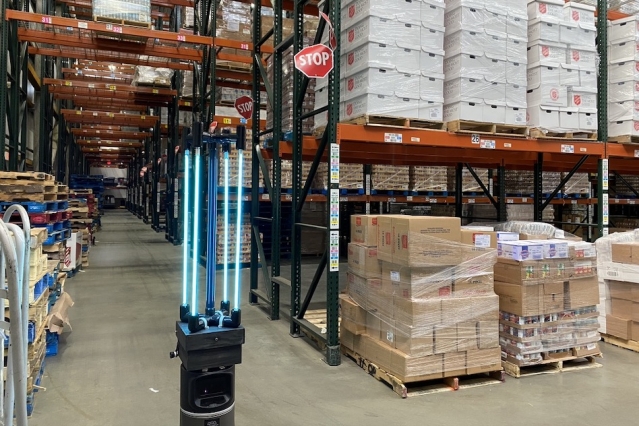Fan Cheng MIT researchers developed a CSAIL robot to disinfect the greater Boston food bank
Published on:2020-07-01
There are many droplets that we cant see, touch or feel in the air. The threat of Covid-19 COVID-19 persists. Preventing these particles from spreading is becoming more and more important, especially on the surface of many objects.
Fortunately, chemical cleaning products are effective, but using them to disinfect larger environments can be expensive, dangerous and time-consuming. Globally, thousands of warehouses, grocery stores, schools and other places where cleaners are at risk.

With this in mind, the MIT Computer Science and Artificial Intelligence Laboratory (CSAIL) team, in cooperation with AVA robotics and the greater Boston food bank (gbfb), designed a new robot system that can effectively disinfect the surface of objects and neutralize the aerosol form of coronavirus.
This method uses CSAIL to design customized UV-C lamps, which are integrated with AVA robotics mobile robot base, and can be used for autonomous UV disinfection in other environments such as factories, restaurants and supermarkets.
It has been proved that UV-C lamp can effectively kill viruses and bacteria on the surface and aerosol, but it is unsafe for human exposure. Fortunately, Avas mobile robot doesnt need any manual supervision. The array uses short wave ultraviolet light to kill microorganisms and destroy their DNA, which is called ultraviolet bactericidal radiation.
A complete robotic system can map space - in this case, the greater Boston food bank (gbfb), the warehouse of a U.S. non-profit organization that provides hunger relief, and navigate between waypoints and other designated areas. In testing the system, the team used a UV-C dosimeter that confirmed that the robot was providing the expected dose of UV-C light predicted by the model.

During gbfb testing, the robot can drive pallets and storage channels at a speed of about 0.22 miles per hour. At this speed, the robot can cover a 4000 square foot space in the gbfb warehouse in half an hour. During this time, ultraviolet light can neutralize about 90% of coronaviruses on various surfaces. For many surfaces, this dose will be higher, resulting in more viruses being neutralized.
Usually, this ultraviolet sterilization method is mainly used in hospitals and medical places to disinfect wards and prevent the transmission of microorganisms such as methicillin-resistant Staphylococcus aureus and Clostridium difficile, while UV-C lamps can also resist airborne pathogens.
The robot was initially operated remotely by a remote user who would teach the robot which way to go around the warehouse, but then it could operate independently. Before returning to the base, it can reach the path points defined on its map, such as loading dock and transportation floor.
These waypoints are defined by human users in the initial remote operation mode, and they can add new waypoints to the map as needed. In gbfbs factory, workers cross the corridor every day to collect products for partners and up to 50 pickup trucks. By focusing on the transportation area, the robot gives priority to items leaving the warehouse to reduce the spread of the virus to the community. Although it is most effective in a straight line, when light is reflected from the surface to other surfaces, UVC rays can reach corners and gaps, and can also fight airborne pathogens.
The MIT team is exploring how to use on-board sensors to adapt to changes in the environment. When the robot is deployed, it does not know which channel will be occupied or which road is the most crowded. Therefore, the robot needs to learn between the occupied and unoccupied channels so that it can change the path accordingly.
MIT is also studying the potential of these robots for teamwork. "As we drive the robot around the food depot, we are also studying new control policies to enable the robot to adapt to changes in the environment and ensure that all areas receive appropriate dose estimates," Pearson said
Researchers are focusing on remote operation research and development to minimize manual supervision when running the system, so as to reduce the additional risk of covid-19 transmission.
Fortunately, chemical cleaning products are effective, but using them to disinfect larger environments can be expensive, dangerous and time-consuming. Globally, thousands of warehouses, grocery stores, schools and other places where cleaners are at risk.

With this in mind, the MIT Computer Science and Artificial Intelligence Laboratory (CSAIL) team, in cooperation with AVA robotics and the greater Boston food bank (gbfb), designed a new robot system that can effectively disinfect the surface of objects and neutralize the aerosol form of coronavirus.
This method uses CSAIL to design customized UV-C lamps, which are integrated with AVA robotics mobile robot base, and can be used for autonomous UV disinfection in other environments such as factories, restaurants and supermarkets.
It has been proved that UV-C lamp can effectively kill viruses and bacteria on the surface and aerosol, but it is unsafe for human exposure. Fortunately, Avas mobile robot doesnt need any manual supervision. The array uses short wave ultraviolet light to kill microorganisms and destroy their DNA, which is called ultraviolet bactericidal radiation.
A complete robotic system can map space - in this case, the greater Boston food bank (gbfb), the warehouse of a U.S. non-profit organization that provides hunger relief, and navigate between waypoints and other designated areas. In testing the system, the team used a UV-C dosimeter that confirmed that the robot was providing the expected dose of UV-C light predicted by the model.

During gbfb testing, the robot can drive pallets and storage channels at a speed of about 0.22 miles per hour. At this speed, the robot can cover a 4000 square foot space in the gbfb warehouse in half an hour. During this time, ultraviolet light can neutralize about 90% of coronaviruses on various surfaces. For many surfaces, this dose will be higher, resulting in more viruses being neutralized.
Usually, this ultraviolet sterilization method is mainly used in hospitals and medical places to disinfect wards and prevent the transmission of microorganisms such as methicillin-resistant Staphylococcus aureus and Clostridium difficile, while UV-C lamps can also resist airborne pathogens.
The robot was initially operated remotely by a remote user who would teach the robot which way to go around the warehouse, but then it could operate independently. Before returning to the base, it can reach the path points defined on its map, such as loading dock and transportation floor.
These waypoints are defined by human users in the initial remote operation mode, and they can add new waypoints to the map as needed. In gbfbs factory, workers cross the corridor every day to collect products for partners and up to 50 pickup trucks. By focusing on the transportation area, the robot gives priority to items leaving the warehouse to reduce the spread of the virus to the community. Although it is most effective in a straight line, when light is reflected from the surface to other surfaces, UVC rays can reach corners and gaps, and can also fight airborne pathogens.
The MIT team is exploring how to use on-board sensors to adapt to changes in the environment. When the robot is deployed, it does not know which channel will be occupied or which road is the most crowded. Therefore, the robot needs to learn between the occupied and unoccupied channels so that it can change the path accordingly.
MIT is also studying the potential of these robots for teamwork. "As we drive the robot around the food depot, we are also studying new control policies to enable the robot to adapt to changes in the environment and ensure that all areas receive appropriate dose estimates," Pearson said
Researchers are focusing on remote operation research and development to minimize manual supervision when running the system, so as to reduce the additional risk of covid-19 transmission.

